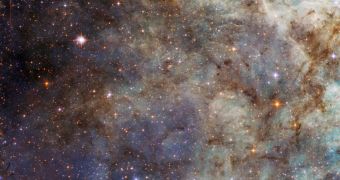Using its Advanced Camera for Surveys (ACS) instrument, the NASA/ESA Hubble Space Telescope was recently able to produce a splendid image of the Tarantula Nebula, boasting a field of view of approximately 3.3 by 3.3 arcminutes.
The view is centered on the outskirts of the main clouds in the nebula, which are made up of ionized hydrogen gas. Such an environment is known among astronomers as an H-II region. These areas are extremely proficient at forming new stars.
While the gas appears green in this image, the true color of the clouds is red. The change occurs on account of the filters and color codes introduced in this multi-wavelength image. The ACS photographed Tarantula's outskirts in both visible and infrared wavelengths.
H-II regions are known to contain newly-formed stars that are still smothered in a cocoon of gas and dust. After forming through the collapse of massive hydrogen clouds, these protostars continue to accrete matter from their environment until they become strong enough to clear out their surroundings.
This is done through the accretion of vast amounts of materials and the production of intense stellar winds, which swirl the gas and push it away. In some stellar nurseries, this process leaves behind tightly-packed agglomerations of celestial fireballs called stellar clusters.
Most of the ionization affecting the gas inside stellar nurseries occurs on account of the massive amount of ultraviolet radiation being produced by the young protostars. This is largely what makes the Tarantula the brightest known nebula in the entire Local Group of galaxies.
At roughly 650 light-years across, the Tarantula Nebula is the largest and most active stellar nursery ever discovered in our galactic neighborhood. To get a sense of scale, the entire Milky Way is roughly 120,000 light-years across.
The formation is located about 170,000 light-years away, in the Large Magellanic Cloud. The latter is a dwarf galaxy orbiting the Milky Way, alongside the Small Magellanic Cloud. Astronomers estimate that hundreds of yet-undiscovered, small galaxies may be flying around the Milky Way.
“The cluster at the Tarantula nebula’s center is relatively young and very bright. While it is outside the field of view of this image, the energy from it is responsible for most of the brightness of the Nebula, including the part we see here,” NASA experts say.
“The nebula is in fact so luminous that if it were located within 1,000 light-years from Earth, it would cast shadows on our planet,” they conclude.

 14 DAY TRIAL //
14 DAY TRIAL //